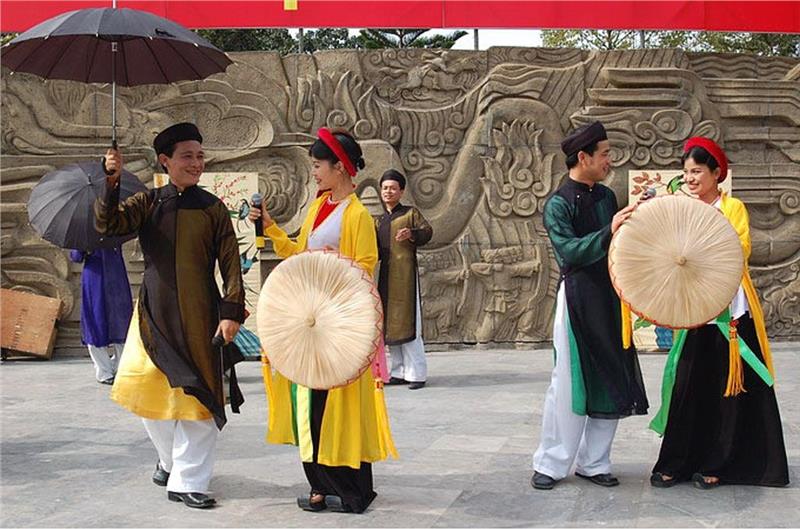There are total of 54 ethnic groups in Vietnam, which creates diversity in culture of the country. Among these ethnic groups, the proportion of Kinh people in total population is the biggest. They are also one of the most ancient people in Vietnam. Their costume plays an important part in cultural and religious life of Vietnamese people. Vietnamese costume, in general, is simple, modest in the harmony with the nature and realistic conditions. Costume of Vietnamese people also reflects their spiritual life. Traditionally, in feudal period, Vietnamese men wore brown shirts and white trousers with a simple cloth wrapped around their head, and simple sandals for their footwear. In some formal ceremonies, they often wore clothes in black or dark colors. In almost ancient time of Vietnam, women wore shirts in brown and long skirts in black with headgears of black turban. The major materials were cotton; only costume of the rich was made of silk. Only costume of royal class was in yellow. Meanwhile, colors of purple, blue and red were used for high-ranking mandarin. Along with the development of society, Vietnamese costume changed gradually. During the time, Vietnamese people had to struggle for invasion of other domination, thus, their costume was not too complicated.

In 19th century, Vietnamese people wore short shirts in the north of Vietnam, while they were called Ao Ba Ba in Southern Vietnam and a little longer. In early 20th century, Ao tu than, “four-part dress”, was the most outstanding Vietnamese traditional dress. This costume was mainly wore by female northerners. Nowadays, Ao tu than has been appeared in special occasions in Northern Vietnam, especially in Bac Ninh Province. The costume consists of a flowing outer tunic which is open at the front, like a jacket; at the waist, the tunic splits into two flaps, a full flap in the back (made up of two flaps sewn together) and the two flaps in the front which are not sewn together but can be tied together or left dangling. They used a silk sash to tie as a belt. Under the tunic, they wore a long skirt. Inside the outer was “Yem”, an ancient bodice of Vietnamese women. Ao tu than during this time were made in different colors in combination with several sophisticated jewelries. Ao tu than became the soul and cream of Vietnamese culture.

In the middle 20th century, Ao Dai Vietnam gradually appeared. The traditional Ao tu than was changed and modified with two long slits along the side, which forms two panels in the front and at the back of the dress. These two panels looks freely floating, creating charm in Vietnamese women when they move. This dress is combined with a long pair of white silk trousers. In addition, conical hat was flexibly in harmony with Ao dai. This type of hats helps Vietnamese women avoid fierce sunshine and rain in this tropical country. This hat is made of palm leaves which are dried under sunshine. The Ao Dai was preferred by Vietnamese women in both urban and rural areas in Vietnam. They wore Ao Dai when going out, while at home, they wore short shirts, or Ao Ba Ba. Meanwhile, in areas of ethnic minority groups, they had their own traditional costumes. Over the time, their costumes change, but remain their different characteristics. Even though the long domination of Chinese and other powers, Vietnamese people still retain unique cultural feature in their costume. Nowadays, in the 21st century, Vietnamese traditional costume is gradually replaced by modern and fashionable clothes. Vietnamese people only wear traditional clothes as Ao Dai or Ao tu than in special and traditional occasions. Since the development of society and conditions of working and communication, traditional costumes are seldom suitable. However, traditional characteristics still appear on every clothes of Vietnamese people. Ao dai Vietnam, although, becomes modern to match the current life, it still has its own features that makes the beauty of Vietnamese people.
